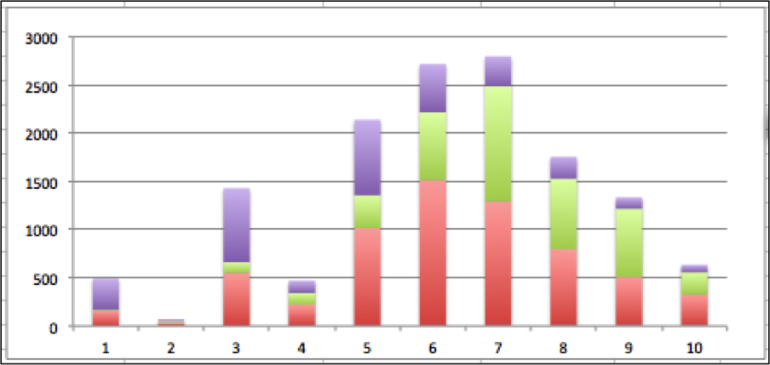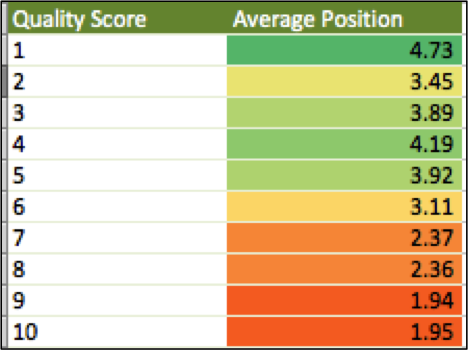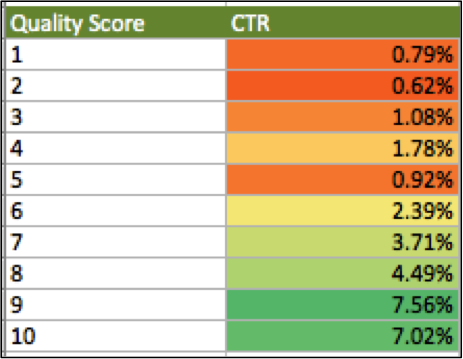One of the most popular topics in the PPC community is quality score. As account managers we are always trying to improve this number, theorizing the factors that impact this number, and striving to get our clients to understand it’s impact.
For this post I took keyword level data and quality scores from 5 clients. In total I used over 68,000 keywords. The data comes from 1 healthy account, 2 accounts that need improvement and 2 accounts we would consider to be unhealthy. I defined the healthy account as the account with an average quality score of 7.54 across all the enabled keywords. The 2 accounts that need improvement have an average quality score among all enabled keywords between a 5 and 7. Lastly, the 2 unhealthy accounts were both below 5 in average quality score between all the keywords.
Using this data I wanted to see what conclusions if any we could make. I also wanted to take the data and arm you with recommendations for your own accounts. I asked questions and tried to see what the data could tell me about quality score.
Question 1: Is there an ideal match type distribution for a strong quality score?
Answer: There does not appear to be an ideal distribution of match types. However, I would lean towards increasing exact match keywords to improve quality score. Looking at the data below we can see that Client 1 clearly has a significant amount of the keywords in the account set to exact match.

Question 2: Does Google use quality score to get advertisers to pay more?
Answer: No, using the data from 5 clients, if anything the quality scores appeared to be distributed higher than a 5.

Question 3: Are keywords in higher positions awarded a higher quality score?
Answer: Yes, unfortunately like most metrics in the PPC world, however, it is hard to take this metric in isolation because an advertiser with better quality scores is going to be able to pay to be in the top spots and is realizing the benefit of lower CPCs as a reward for keyword alignment.

Question 4: This is the age old question, does CTR impact the quality score?
Answer: Yes. Using the data we have it is very clear that the stronger the CTR the higher the quality score. While we do see some data that is showing a strong CTR in a below average quality score, this is more than likely because some advertisers choose to pay more to take higher spots and as a result pay higher CPCs. Long run however this could be a strategy to reduce bids.

While this is only one set of data and a mere 68,000 keywords, I can honestly say that I hoped for more solid earth shattering PPC news based on the data. However, I think if you take the data at a high level and take the answers as a cohort rather than as individual answers we can see that if you use properly aligned keywords, you will be rewarded with a high quality score.
The data also shows that Google isn’t working against advertisers and that if a keyword is aligned, a higher quality score will be granted. Lastly, a higher CTR is definitely associated with a higher quality score. Emphasizing the importance of relevance from search query to landing page will hopefully help to improve both CTR and conversion rate. Here are the following recommendations based on the data from this test.
Make sure your keyword list is highly relevant
A confident advertiser starts with exact terms. We are selling blue widets. They don’t bid on clubs, tools and bats but rather “blue widgets” and that term exactly. Focus on what the client is trying to sell and move up the ladder from that starting point.
Group the keywords into tight themes
Once you have come up with a list of terms that match what the advertiser is selling make sure that you group these terms together. For example, you can group terms by brand, product type or even intent but keeping the keywords aligned and grouped together is going to enable you to have ad copy and a landing page that matches the search terms in the account.
Do not continue to promote keywords that are not working
If a modified broad match keyword is not performing try it in phrase or exact match. If the keyword is still showing poor results, it may not be the right keyword for your brand. Try to become attached to the data rather than the search term itself. Don’t allow the account to get cluttered with keywords that do not resonate with the audience. While PPC is marketing and advertising, the search channel is about being present when the user is looking to fill a specific need.
Measure the data
The nice part about working in PPC is that we are rewarded with constant data. It is important to use that data wisely. While it can be challenging to tell a client to “improve the quality score” in the account, you can go though the exercise of making sure keywords are aligned with the experience and then using the quality score metric as additional data. It then becomes a matter of both qualitative and quantitative data that drives the business decision.
Conclusion
This data can be used to recommend to our clients that keywords be aligned to the products and services being provided. While all clients want volume when we target keywords that are too broad in scope or relevancy, often times it makes for a poor user experience for the searcher and we won’t be awarded the click, tying back to higher CPCs at the end of the day.
While this post doesn’t necessarily contain new sentiments, the take-away is to really look at the data as a whole and make recommendations to clients that serve their individual campaigns and goals. Quality score is important to an account and taking the time to tie the metric back to recommendations that can be implemented for the client will help to improve metrics.




